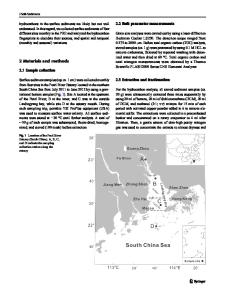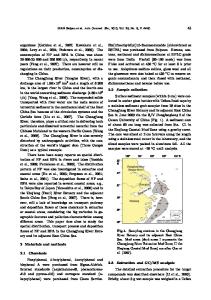Spatial distribution of heavy metals in surface sediments from the Ganges River basin, Bangladesh
- PDF / 1,912,098 Bytes
- 12 Pages / 595.276 x 790.866 pts Page_size
- 89 Downloads / 391 Views
ORIGINAL PAPER
Spatial distribution of heavy metals in surface sediments from the Ganges River basin, Bangladesh H. M. Zakir Hossain 1,2 & Quazi Hasna Hossain 2 & Md. Sultan-Ul-Islam 3 Received: 13 December 2018 / Accepted: 9 September 2019 # Saudi Society for Geosciences 2019
Abstract The spatial distribution and source of heavy metals (Ba, Cr, Ni, Pb, V, As, Zn, and Cu) in surface sediments of the Ganges River basin, Bangladesh, were investigated using the geo-accumulation index (Igeo), contamination factor (CF), and pollution load index (PLI). The sequences of mean concentrations of the studied heavy metals are in decreasing order as follows: Ba > V > Cr > Zn > Pb > Ni > As > Cu > Hg. Sediments in the Ganges River basin are characterized by low to moderate Igeo values for Ni, Zn, Pb, and V, while high values for Ba, As, Cu, and Cr, indicating low to moderate/high contamination of the river sediments. The mean CF load in the sediments shows that Ba is highly enriched, having moderate enrichment of As, Cu, and Cr, and relatively low enrichment of Pb, V, Zn, and Ni for the lower river basin reflecting high to moderate degree of metal pollution of the sediments. The PLI values range from 0.11 to 5.89 (average 0.88 ± 1.28) and 0.41 to 8.79 (average 2.13 ± 1.81) for the upper and lower Ganges River basin, respectively, which suggests that the enhanced metal pollution in the latter site is due to the threat of progressive industrialization. The principal component analysis (PCA) and hierarchical clustering (CA) records imply that the sediment samples are primarily polluted by As, Cu, Cr, and Ni resulting from anthropogenic sources. The mean Igeo and PLI values further reflecting high level of metal contamination in the lower Ganges River basin and relatively low level of contamination in the upper basin. Keywords Heavy metal . Geo-accumulation index . Pollution load index . Hierarchical cluster analysis . Ganges River basin . Bangladesh
Introduction Heavy metal pollution of sediments is a major environmental concern in developing countries (e.g., Bangladesh, India, China, Malaysia etc.) in the last few decades owing to rapid urbanization and industrialization (Selvaraj et al. 2004; Hossain et al. 2015; Khan et al. 2017; Duncan et al. 2018). Accumulation of heavy metals in the modern sediments has Responsible Editor: Domenico M. Doronzo * H. M. Zakir Hossain [email protected] 1
Department of Petroleum and Mining Engineering, Jashore University of Science and Technology, Jashore 7408, Bangladesh
2
Department of Geoscience, Shimane University, 1060 Nishikawatsu, Matsue 690-8504, Japan
3
Department of Geology and Mining, University of Rajshahi, Rajshahi 6205, Bangladesh
become a worldwide environmental problem due to their exposure to earth surface environments as well as sink to the aquatic regimes. It is a well-known recognized fact that sediments play a significant reservoir for the accumulation of toxic heavy metals released from rocks, agricultural materials, and industries (Huang et al. 2014; Hossain et al.
Data Loading...











